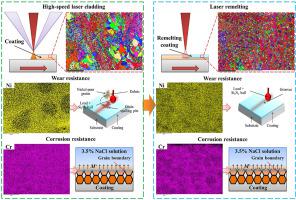Intermetallics ( IF 4.3 ) Pub Date : 2022-08-13 , DOI: 10.1016/j.intermet.2022.107686 Zhenzeng Chong , Yaoning Sun , Wangjun Cheng , Liufei Huang , Chenyang Han , Xufeng Ma , Acong Meng

|
To further strengthen the AlCoCrFeNi high-entropy alloy (HEA) coating prepared by high-speed laser cladding (HLC), laser remelting (LR) was chosen to reprocess it. The effects of LR on the topography, microstructure, growth orientation, phase distribution, and properties were investigated. It was revealed that there were a large number of liquid phase separation (LPS) zones in the HLC coating because of an ultrafast cooling rate. After LR, the LPS zones were eliminated. Compared to HLC coating, the microhardness increased from 622 HV to 762 HV, and the friction coefficient and the wear weight loss were reduced by 0.1 and 0.5 mg, respectively. In electrochemical testing, the self-corrosion potential increased by 45.9 mV and the self-corrosion current density decreased by one order of magnitude. Meanwhile, EBSD analysis indicated that the LPS zones were prone to recrystallization. The LPS zones were nickel-poor, low hardness, also BCC phase, and had a clearer (101) orientation. With the elimination of the LPS zones, the kernel average misorientation values were reduced, Taylor factor values and high angle grain boundaries were increased, and the average grain size was reduced from 2.43 μm to 2.12 μm. Eventually, for LR coatings, the combination of fine grain strengthening, solid solution strengthening, spalling reduction, and Cr element segregation resulted in better wear and corrosion resistances. The overall results show that a reasonable LR application can induce the microstructure of the HLC coating and improve its service properties.
中文翻译:

激光重熔在高速激光熔覆 AlCoCrFeNi 高熵合金涂层中引起晶粒细化和性能增强
为了进一步强化高速激光熔覆(HLC)制备的AlCoCrFeNi高熵合金(HEA)涂层,选择激光重熔(LR)对其进行再加工。研究了 LR 对形貌、微观结构、生长取向、相分布和性能的影响。结果表明,由于超快的冷却速度,在 HLC 涂层中存在大量液相分离 (LPS) 区。在 LR 之后,LPS 区域被消除。与 HLC 涂层相比,显微硬度从 622 HV 提高到 762 HV,摩擦系数和磨损重量损失分别降低了 0.1 和 0.5 mg。在电化学测试中,自腐蚀电位提高了45.9 mV,自腐蚀电流密度降低了一个数量级。同时,EBSD分析表明LPS区易于再结晶。LPS 区是贫镍、低硬度、也是 BCC 相,并且具有更清晰的 (101) 取向。随着LPS区的消除,内核平均取向差值减小,泰勒因子值和高角晶界增加,平均晶粒尺寸从2.43 μm减小到2.12 μm。最终,对于 LR 涂层,细晶粒强化、固溶强化、剥落减少和 Cr 元素偏析的组合产生了更好的耐磨性和耐腐蚀性。总体结果表明,合理的 LR 应用可以诱导 HLC 涂层的微观结构并改善其使用性能。并且有更清晰的(101)方向。随着LPS区的消除,内核平均取向差值减小,泰勒因子值和高角晶界增加,平均晶粒尺寸从2.43 μm减小到2.12 μm。最终,对于 LR 涂层,细晶粒强化、固溶强化、剥落减少和 Cr 元素偏析的组合产生了更好的耐磨性和耐腐蚀性。总体结果表明,合理的 LR 应用可以诱导 HLC 涂层的微观结构并改善其使用性能。并且有更清晰的(101)方向。随着LPS区的消除,内核平均取向差值减小,泰勒因子值和高角晶界增加,平均晶粒尺寸从2.43 μm减小到2.12 μm。最终,对于 LR 涂层,细晶粒强化、固溶强化、剥落减少和 Cr 元素偏析的组合产生了更好的耐磨性和耐腐蚀性。总体结果表明,合理的 LR 应用可以诱导 HLC 涂层的微观结构并改善其使用性能。最终,对于 LR 涂层,细晶粒强化、固溶强化、剥落减少和 Cr 元素偏析的组合产生了更好的耐磨性和耐腐蚀性。总体结果表明,合理的 LR 应用可以诱导 HLC 涂层的微观结构并改善其使用性能。最终,对于 LR 涂层,细晶粒强化、固溶强化、剥落减少和 Cr 元素偏析的组合产生了更好的耐磨性和耐腐蚀性。总体结果表明,合理的 LR 应用可以诱导 HLC 涂层的微观结构并改善其使用性能。










































 京公网安备 11010802027423号
京公网安备 11010802027423号